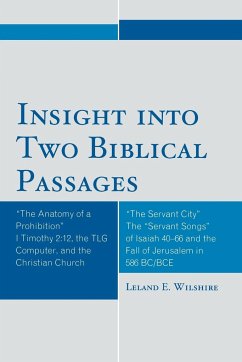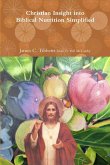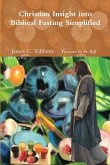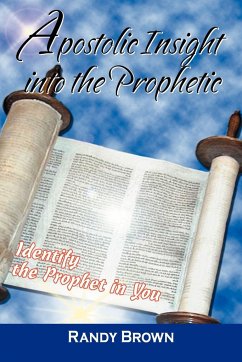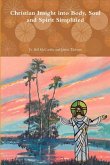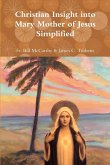Leland E. Wilshire
Insight into Two Biblical Passages
Anatomy of a Prohibition I Timothy 2:12, the TLG Computer, and the Christian Church
Leland E. Wilshire
Insight into Two Biblical Passages
Anatomy of a Prohibition I Timothy 2:12, the TLG Computer, and the Christian Church
- Broschiertes Buch
- Merkliste
- Auf die Merkliste
- Bewerten Bewerten
- Teilen
- Produkt teilen
- Produkterinnerung
- Produkterinnerung
The first study uses the TLG computer database for a new interpretation of I Timothy 2.12, exploring the effect of the interpretation on exegesis, gender pronouncements, hermeneutics, tradition, theology, and relevance. The second insight study discusses seeing the 'suffering servant' of Isaiah 40-55 as the city of Jerusalem.
Andere Kunden interessierten sich auch für
![Christian Insight into Biblical Nutrition Simplified Christian Insight into Biblical Nutrition Simplified]() James C. Tibbe Intro. Fr. Bill McCarthyChristian Insight into Biblical Nutrition Simplified18,99 €
James C. Tibbe Intro. Fr. Bill McCarthyChristian Insight into Biblical Nutrition Simplified18,99 €![Awakening Through Insight Intuition Awakening Through Insight Intuition]() Cheryl DriskellAwakening Through Insight Intuition28,99 €
Cheryl DriskellAwakening Through Insight Intuition28,99 €![Christian Insight into Biblical Fasting Simplified Christian Insight into Biblical Fasting Simplified]() Forward by James C. T Fr. Bill McCarthyChristian Insight into Biblical Fasting Simplified16,99 €
Forward by James C. T Fr. Bill McCarthyChristian Insight into Biblical Fasting Simplified16,99 €![Apostolic Insight Into The Prophetic Apostolic Insight Into The Prophetic]() Randy BrownApostolic Insight Into The Prophetic25,99 €
Randy BrownApostolic Insight Into The Prophetic25,99 €![Embrace Ultra-Ability! Wisdom, Insight & Motivation from the Blind Who Sees Far and Wide Embrace Ultra-Ability! Wisdom, Insight & Motivation from the Blind Who Sees Far and Wide]() Shirley ChengEmbrace Ultra-Ability! Wisdom, Insight & Motivation from the Blind Who Sees Far and Wide18,99 €
Shirley ChengEmbrace Ultra-Ability! Wisdom, Insight & Motivation from the Blind Who Sees Far and Wide18,99 €![Christian Insight into Body, Soul and Spirit Simplified Christian Insight into Body, Soul and Spirit Simplified]() Fr. Bill McCarthy and James TibbettsChristian Insight into Body, Soul and Spirit Simplified18,99 €
Fr. Bill McCarthy and James TibbettsChristian Insight into Body, Soul and Spirit Simplified18,99 €![Christian Insight into Mary Mother of Jesus Simplified Christian Insight into Mary Mother of Jesus Simplified]() Fr. Bill McCarthy James C. Tibbetts &Christian Insight into Mary Mother of Jesus Simplified16,99 €
Fr. Bill McCarthy James C. Tibbetts &Christian Insight into Mary Mother of Jesus Simplified16,99 €-
-
-
The first study uses the TLG computer database for a new interpretation of I Timothy 2.12, exploring the effect of the interpretation on exegesis, gender pronouncements, hermeneutics, tradition, theology, and relevance. The second insight study discusses seeing the 'suffering servant' of Isaiah 40-55 as the city of Jerusalem.
Hinweis: Dieser Artikel kann nur an eine deutsche Lieferadresse ausgeliefert werden.
Hinweis: Dieser Artikel kann nur an eine deutsche Lieferadresse ausgeliefert werden.
Produktdetails
- Produktdetails
- Verlag: Globe Pequot Publishing Group Inc/Bloomsbury
- Seitenzahl: 154
- Erscheinungstermin: 10. Juni 2010
- Englisch
- Abmessung: 229mm x 152mm x 9mm
- Gewicht: 234g
- ISBN-13: 9780761852070
- ISBN-10: 0761852077
- Artikelnr.: 29985700
- Herstellerkennzeichnung
- Libri GmbH
- Europaallee 1
- 36244 Bad Hersfeld
- gpsr@libri.de
- Verlag: Globe Pequot Publishing Group Inc/Bloomsbury
- Seitenzahl: 154
- Erscheinungstermin: 10. Juni 2010
- Englisch
- Abmessung: 229mm x 152mm x 9mm
- Gewicht: 234g
- ISBN-13: 9780761852070
- ISBN-10: 0761852077
- Artikelnr.: 29985700
- Herstellerkennzeichnung
- Libri GmbH
- Europaallee 1
- 36244 Bad Hersfeld
- gpsr@libri.de
By Leland E. Wilshire
Part 1 The Anatomy of Prohibition: I Timothy 2.12, the TLG Computer, and
the Christian Church Chapter 2 Foreword Chapter 3 Preface Part 4 Part I
Chapter 5 1. The I Timothy 2.12 Passage and Its Difficulties Chapter 6 2.
Phillology, Lexicons, and the Computer Databank: A New Opening in
Understanding the I Tim. 2.12 Prohibition Chapter 7 3. A 1984 Attempt by
George W. Knight III, by the use of Lexicons, to deal with the word
authentein Chapter 8 4. The Use of the Computer Data and Other Citations in
a Background Study of the Word AUTHENTEO in I Tim. 2.12 Chapter 9 5. A New
Interpretation of the I Tim. 2.12 Prohibition in Light of the New Computer
Databank Understanding Chapter 10 6. Three Sample Alternative Approaches:
that of Paul W. Barnett, Catherine C. Kroeger, and the Editors of Women in
the Church Part 11 Part II Chapter 12 Introduction: The Anatomy of
Prohibition: The New Interpretation and its Contemporary Applications
Chapter 13 1. Exegesis Chapter 14 2. Gender Chapter 15 3. Hermeneutics
Chapter 16 4. Tradition Chapter 17 5. Theology Chapter 18 6. Authority
Chapter 19 7. Ecclesiology Chapter 20 8. Relevance Part 21 Supplement: The
Anatomy of Prohibition: A History of Traditional Translations,
Mistranslations, and Interpretations Chapter 22 1. The Use of I Tim. 2.12
Prohibition in the Traditional Interpretations of the Greek Early Church
Chapter 23 2. The Use of the Prohibition in the Traditional Translations
and Interpretations of the Latin Early Church Chapter 24 3. Traditional
Translations and Interpretations of the Prohibition during the Middle Ages
Chapter 25 4. Reformulations of the Prohibition during the Era of the
Renaissance and Reformation Chapter 26 5. Differing English Translations of
the I Tim. 2.12 Prohibition in Modern History and their Use in the Current
Understandings of Women in Ecclesiastical Leadership Chapter 27 Notes
Chapter 28 Working Bibliography Part 29 The Servant City: The "Servant
Songs" of Isaiah 40-66 and the Fall of Jerusalem in 586 BC/BCE Chapter 30
Foreword Chapter 31 Preface Chapter 32 1. Background: Three Interpretations
of the Fall of Jerusalem 586 BC/BCE Chapter 33 2. The "Suffering Servant"
Metaphor in the "Servant Songs" of Isaiah 40-66 Relating to the Destruction
of the City of Jerusalem Chapter 34 3. The Voice of the Isaianic "Servant
Songs" within the Ancient Near Eastern Literary Tradition of Destroyed
Cultic Centers Chapter 35 4. The Meaning and Future of the "Suffering
Servant" Metaphor in "Isaiah" (Isaiah 40-66) Concerning the Destruction of
Jerusalem Chapter 36 Notes Chapter 37 Working Bibliography
the Christian Church Chapter 2 Foreword Chapter 3 Preface Part 4 Part I
Chapter 5 1. The I Timothy 2.12 Passage and Its Difficulties Chapter 6 2.
Phillology, Lexicons, and the Computer Databank: A New Opening in
Understanding the I Tim. 2.12 Prohibition Chapter 7 3. A 1984 Attempt by
George W. Knight III, by the use of Lexicons, to deal with the word
authentein Chapter 8 4. The Use of the Computer Data and Other Citations in
a Background Study of the Word AUTHENTEO in I Tim. 2.12 Chapter 9 5. A New
Interpretation of the I Tim. 2.12 Prohibition in Light of the New Computer
Databank Understanding Chapter 10 6. Three Sample Alternative Approaches:
that of Paul W. Barnett, Catherine C. Kroeger, and the Editors of Women in
the Church Part 11 Part II Chapter 12 Introduction: The Anatomy of
Prohibition: The New Interpretation and its Contemporary Applications
Chapter 13 1. Exegesis Chapter 14 2. Gender Chapter 15 3. Hermeneutics
Chapter 16 4. Tradition Chapter 17 5. Theology Chapter 18 6. Authority
Chapter 19 7. Ecclesiology Chapter 20 8. Relevance Part 21 Supplement: The
Anatomy of Prohibition: A History of Traditional Translations,
Mistranslations, and Interpretations Chapter 22 1. The Use of I Tim. 2.12
Prohibition in the Traditional Interpretations of the Greek Early Church
Chapter 23 2. The Use of the Prohibition in the Traditional Translations
and Interpretations of the Latin Early Church Chapter 24 3. Traditional
Translations and Interpretations of the Prohibition during the Middle Ages
Chapter 25 4. Reformulations of the Prohibition during the Era of the
Renaissance and Reformation Chapter 26 5. Differing English Translations of
the I Tim. 2.12 Prohibition in Modern History and their Use in the Current
Understandings of Women in Ecclesiastical Leadership Chapter 27 Notes
Chapter 28 Working Bibliography Part 29 The Servant City: The "Servant
Songs" of Isaiah 40-66 and the Fall of Jerusalem in 586 BC/BCE Chapter 30
Foreword Chapter 31 Preface Chapter 32 1. Background: Three Interpretations
of the Fall of Jerusalem 586 BC/BCE Chapter 33 2. The "Suffering Servant"
Metaphor in the "Servant Songs" of Isaiah 40-66 Relating to the Destruction
of the City of Jerusalem Chapter 34 3. The Voice of the Isaianic "Servant
Songs" within the Ancient Near Eastern Literary Tradition of Destroyed
Cultic Centers Chapter 35 4. The Meaning and Future of the "Suffering
Servant" Metaphor in "Isaiah" (Isaiah 40-66) Concerning the Destruction of
Jerusalem Chapter 36 Notes Chapter 37 Working Bibliography
Part 1 The Anatomy of Prohibition: I Timothy 2.12, the TLG Computer, and
the Christian Church Chapter 2 Foreword Chapter 3 Preface Part 4 Part I
Chapter 5 1. The I Timothy 2.12 Passage and Its Difficulties Chapter 6 2.
Phillology, Lexicons, and the Computer Databank: A New Opening in
Understanding the I Tim. 2.12 Prohibition Chapter 7 3. A 1984 Attempt by
George W. Knight III, by the use of Lexicons, to deal with the word
authentein Chapter 8 4. The Use of the Computer Data and Other Citations in
a Background Study of the Word AUTHENTEO in I Tim. 2.12 Chapter 9 5. A New
Interpretation of the I Tim. 2.12 Prohibition in Light of the New Computer
Databank Understanding Chapter 10 6. Three Sample Alternative Approaches:
that of Paul W. Barnett, Catherine C. Kroeger, and the Editors of Women in
the Church Part 11 Part II Chapter 12 Introduction: The Anatomy of
Prohibition: The New Interpretation and its Contemporary Applications
Chapter 13 1. Exegesis Chapter 14 2. Gender Chapter 15 3. Hermeneutics
Chapter 16 4. Tradition Chapter 17 5. Theology Chapter 18 6. Authority
Chapter 19 7. Ecclesiology Chapter 20 8. Relevance Part 21 Supplement: The
Anatomy of Prohibition: A History of Traditional Translations,
Mistranslations, and Interpretations Chapter 22 1. The Use of I Tim. 2.12
Prohibition in the Traditional Interpretations of the Greek Early Church
Chapter 23 2. The Use of the Prohibition in the Traditional Translations
and Interpretations of the Latin Early Church Chapter 24 3. Traditional
Translations and Interpretations of the Prohibition during the Middle Ages
Chapter 25 4. Reformulations of the Prohibition during the Era of the
Renaissance and Reformation Chapter 26 5. Differing English Translations of
the I Tim. 2.12 Prohibition in Modern History and their Use in the Current
Understandings of Women in Ecclesiastical Leadership Chapter 27 Notes
Chapter 28 Working Bibliography Part 29 The Servant City: The "Servant
Songs" of Isaiah 40-66 and the Fall of Jerusalem in 586 BC/BCE Chapter 30
Foreword Chapter 31 Preface Chapter 32 1. Background: Three Interpretations
of the Fall of Jerusalem 586 BC/BCE Chapter 33 2. The "Suffering Servant"
Metaphor in the "Servant Songs" of Isaiah 40-66 Relating to the Destruction
of the City of Jerusalem Chapter 34 3. The Voice of the Isaianic "Servant
Songs" within the Ancient Near Eastern Literary Tradition of Destroyed
Cultic Centers Chapter 35 4. The Meaning and Future of the "Suffering
Servant" Metaphor in "Isaiah" (Isaiah 40-66) Concerning the Destruction of
Jerusalem Chapter 36 Notes Chapter 37 Working Bibliography
the Christian Church Chapter 2 Foreword Chapter 3 Preface Part 4 Part I
Chapter 5 1. The I Timothy 2.12 Passage and Its Difficulties Chapter 6 2.
Phillology, Lexicons, and the Computer Databank: A New Opening in
Understanding the I Tim. 2.12 Prohibition Chapter 7 3. A 1984 Attempt by
George W. Knight III, by the use of Lexicons, to deal with the word
authentein Chapter 8 4. The Use of the Computer Data and Other Citations in
a Background Study of the Word AUTHENTEO in I Tim. 2.12 Chapter 9 5. A New
Interpretation of the I Tim. 2.12 Prohibition in Light of the New Computer
Databank Understanding Chapter 10 6. Three Sample Alternative Approaches:
that of Paul W. Barnett, Catherine C. Kroeger, and the Editors of Women in
the Church Part 11 Part II Chapter 12 Introduction: The Anatomy of
Prohibition: The New Interpretation and its Contemporary Applications
Chapter 13 1. Exegesis Chapter 14 2. Gender Chapter 15 3. Hermeneutics
Chapter 16 4. Tradition Chapter 17 5. Theology Chapter 18 6. Authority
Chapter 19 7. Ecclesiology Chapter 20 8. Relevance Part 21 Supplement: The
Anatomy of Prohibition: A History of Traditional Translations,
Mistranslations, and Interpretations Chapter 22 1. The Use of I Tim. 2.12
Prohibition in the Traditional Interpretations of the Greek Early Church
Chapter 23 2. The Use of the Prohibition in the Traditional Translations
and Interpretations of the Latin Early Church Chapter 24 3. Traditional
Translations and Interpretations of the Prohibition during the Middle Ages
Chapter 25 4. Reformulations of the Prohibition during the Era of the
Renaissance and Reformation Chapter 26 5. Differing English Translations of
the I Tim. 2.12 Prohibition in Modern History and their Use in the Current
Understandings of Women in Ecclesiastical Leadership Chapter 27 Notes
Chapter 28 Working Bibliography Part 29 The Servant City: The "Servant
Songs" of Isaiah 40-66 and the Fall of Jerusalem in 586 BC/BCE Chapter 30
Foreword Chapter 31 Preface Chapter 32 1. Background: Three Interpretations
of the Fall of Jerusalem 586 BC/BCE Chapter 33 2. The "Suffering Servant"
Metaphor in the "Servant Songs" of Isaiah 40-66 Relating to the Destruction
of the City of Jerusalem Chapter 34 3. The Voice of the Isaianic "Servant
Songs" within the Ancient Near Eastern Literary Tradition of Destroyed
Cultic Centers Chapter 35 4. The Meaning and Future of the "Suffering
Servant" Metaphor in "Isaiah" (Isaiah 40-66) Concerning the Destruction of
Jerusalem Chapter 36 Notes Chapter 37 Working Bibliography

